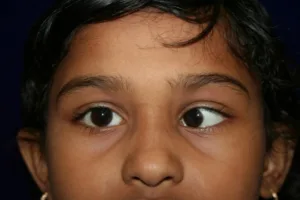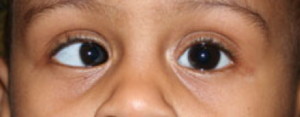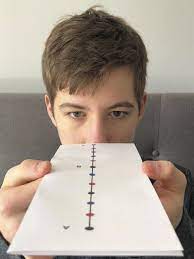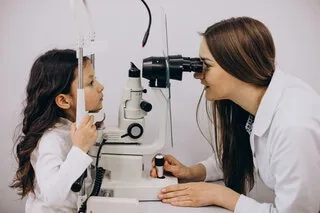
Introduction-
Hello Friends! I am Dr Ashesh Gala, a senior Ophthalmologist practicing at Netrajyot Eye Care Centre at Mulund. Have you ever seen someone whose eyes don’t quite line up? One eye looks straight while the other wanders off. That, my friends, is called a ‘squint Eyes’ or ‘Strabismus‘ in doctor-speak.
It’s like when you try to point at something, but your finger goes off target. Squint can be more than just an odd look; it’s a real eye condition that affects how people see the world.
And guess what? It’s not just a ‘kid thing.’ Adults can have it too. In this blog, we’re diving deep into the world of squint. From spotting it early in kids to sorting it out with treatment, we’ve got it all covered.
So, if you’re curious or concerned about squint, stick around. Let’s straighten out these facts together! 🤓👀
Exploring the Types of Squint Eyes-
Alright, let’s break down the different types of squint, shall we? Think of squint as having different “flavours”, each unique in its way.

First up, we have Esotropia. This is when one eye turns inward. Imagine trying to focus on your nose with one eye. That’s Esotropia for you.

Then there’s Exotropia. It’s the opposite. Here, one eye drifts outward. Picture looking straight but one eye decides to check out what’s happening to the side.

We also have Hypertropia, where one eye moves upward. It’s like trying to look at the top of your head, but only with one eye.

And then, Hypotropia. As you might guess, it’s when one eye points downward. Think of looking at your shoes without tilting your head.
Each type affects how both eyes work together. It’s like a team where one player is not quite in sync with the others. Understanding these types is key to getting the right help. So, if any of these sound familiar, it’s worth a closer look!
Squint Eyes in Children: Spotting the Symptoms
Now, let’s talk about spotting squints in kids. Catching it early is super important.
You know when a kid tries to focus on something, but one eye seems to have a mind of its own? That’s a big hint. It might wander in, out, up, or down. Or, you might see them squinting a lot like they’re trying to focus during a bright day.
Another sign? If they funnily tilt their head while watching TV or looking at you. It’s like they’re trying to get the best angle for both eyes to see clearly.
And hey, if your little one keeps bumping into things on one side, that could be a clue too. It’s like they’re not judging distances right.
So, if you see any of these signs, it’s a good idea to chat with an eye doctor. Early detection can make a big difference in their vision down the road.
Unraveling the Causes of Squint Eyes
Now, let’s unravel the mystery behind what causes squint. It’s a bit like detective work.
Sometimes, it’s just how a child is born. Their eye muscles don’t work together as they should. Imagine a pair of horses pulling a carriage but not quite in sync.
In other cases, it’s more about what the eyes are dealing with like far-sightedness, where distant objects are clearer. The effort to focus can make the eye turn.
Nerve problems can also play a part. Think of it as a glitch in the eye’s wiring. The messages don’t get through correctly.
And sometimes, an injury or illness can lead to squint. It’s like when a football player gets hurt and can’t play his best.
So, squint can come from different causes. Understanding these helps in finding the right way to fix it. Just like knowing why a car broke down helps in repairing it.
Diagnosing Squint Eyes (Strabismus): The Journey to Treatment
Alright, let’s dive into how we diagnose squint or strabismus. It’s the first step on the road to treatment.
It starts with a good, old-fashioned eye exam. The doctor will check how your eyes move. It’s like a little dance for your eyes – up, down, left, right.

Then, there’s the cover test. You know, where one eye is covered, then the other. It shows which eye is doing the heavy lifting.
Sometimes, the doctor will use special drops to dilate your pupils. It’s like opening a window wide to get a better look inside.
For the little ones, there are picture books and toys. It’s a fun way for the doctor to see how their eyes track and focus.
This diagnosis part is super important. It tells the doctor exactly what’s up with your eyes. Think of it as solving a puzzle before finding the right pieces to fix it.
Navigating Through Treatment Options for Squint Eyes
Now, let’s navigate through the treatment options for squint. There are a few paths we can take.
First, the non-surgical route. Glasses, for instance. They’re like giving your eyes a little help to see clearly. Sometimes, that’s all it takes to straighten things out.
Then, there are eye patches. It’s like training for the weaker eye. The patch goes over the stronger eye, making the weaker one work harder.
Eye exercises are another option. Think of them as a gym workout for your eyes. They strengthen the muscles and improve coordination.
But sometimes, we need to step it up a notch. That’s where surgery comes in. It’s like a tune-up for your eye muscles. The Eye surgeon adjusts the muscles to get them working together.
Both paths, surgical and non-surgical, have their place. It’s like choosing between walking or taking the bus. The best route depends on the person and their squint.
Understanding the Right Age for Squint Eyes Surgery
When it comes to squint surgery, a big question is: What’s the right age?
Here’s the thing – there’s no one-size-fits-all answer. In many cases, the earlier, the better. Think of it like fixing a crooked tree. The younger it is, the easier it is to straighten.
But, that doesn’t mean older kids or even adults are out of luck. You see, squint surgery can be effective at almost any age. It’s never too late to get your eyes working better together.
So, whether you’re six or sixty if the squint is cramping your style, surgery might be an option. It’s like deciding when to learn a new skill – the right time is unique for everyone.
Exercises to Manage and Improve Squint Eyes
So, you’re wondering about exercises for squint, right? Good news! There are simple ways to help manage and improve it.

First up, we have pencil push-ups. Hold a pencil out in front of you. Slowly bring it closer, keeping your focus. It’s like playing a slow-motion game of tag with your eyes.

Then, there’s the dot card exercise. Stick a card with dots on the wall. Stare at one dot, then quickly switch to another. It’s like playing connect-the-dots but with your eyes.

Brock String is another cool one. Hold a string with coloured beads at arm’s length. Focus on each bead, one at a time. It’s a bit like climbing a ladder with your eyes.
These exercises are like gym sessions for your eyes. They strengthen the muscles and improve coordination. Remember, it’s not a race. Go slow, be patient, and with time, you might see some real improvements!
The Recovery Process Post-Squint Eyes Surgery
After squint surgery, what’s the recovery like? Let’s set the scene.
Think of it like healing after a small sports injury. Your eyes need rest and time to heal. For the first few days, they might feel sore or itchy. It’s like having a scratch that you shouldn’t touch.
You’ll probably have an eye patch for a bit. It’s like putting a protective cover on a fresh paint job.
Also, there might be some redness or a bit of swelling. It’s normal, like a bruise that fades away.
The doctor will give you some eye drops too. They’re like a soothing balm, helping your eyes heal and stay comfy.
Most folks get back to their routine in a few days. But remember, every person heals differently. It’s like how some people get over a cold faster than others. Just give your eyes the time they need, and you’ll be back to normal before you know it!
Does Squint Eyes Return Post Surgery?
A question I often hear is, “Can squint come back after surgery?” Let’s clear this up.
Most times, squint surgery does the trick. It’s like fixing a bike’s alignment. Once it’s set, you’re good to go. But, just like any medical procedure, there are no 100% guarantees. In some cases, the squint might make a comeback. It’s rare, but it happens.
Think of it as a plant that grows back crooked, even after straightening it. If the squint does return, it’s usually not as severe as before. And don’t worry, there are ways to handle it. Sometimes, a little more treatment or a touch-up surgery can set things straight again.
Remember, every eye is unique. Just like every person is different. So, the outcome can vary. But know this: we’re here to help, every step of the way.
Preventing Squint Eyes: Proactive Measures
Want to know how to potentially prevent squint? It’s all about being proactive.

First off, regular eye check-ups are key. It’s like taking your car for a tune-up. Catching any issues early can stop them from becoming bigger problems.

For the kiddos, limit screen time. Too much TV or tablet time can strain those little eyes. Think of it as a diet for the eyes – balance is crucial.

Protect those peepers from the sun with sunglasses. Just like sunscreen protects skin, sunglasses shield eyes from harmful rays.
And if you notice any unusual signs, like constant squinting or head tilting, don’t wait. Get it checked out. It’s like hearing a strange noise in your car’s engine. Better to check it early than to wait until it gets worse.
These simple steps can go a long way in keeping squint at bay. Remember, taking care of your eyes is a daily thing, just like brushing your teeth!
Identifying Candidates for Squint Eyes Surgery
who needs squint surgery? Let’s figure this out.
Think of a squint like a door that’s off its hinges. Sometimes, a little push is enough. Other times, you need to fix the hinges. That’s where surgery comes in.
If glasses or exercises aren’t doing enough, surgery might be the next step. It’s for those whose squint is pretty noticeable – like a door that just won’t stay shut.
Also, if the squint is causing double vision or serious eye strain, surgery could be the answer. It’s like when you need a mechanic, not just a bit of oil, to fix your bike.
But remember, it’s not a one-size-fits-all solution. Each eye is unique, like a fingerprint. So, the decision for surgery is always personalized. If you’re thinking it might be time for surgery, the best first step is a chat with your eye doctor. They’ll help guide you down the right path.
The Cost of Squint Eyes Surgery in India
Let’s talk about the cost of squint eye surgery in India. It’s like planning a budget for an important project.
The cost can vary. It’s like shopping for a phone – different models, different prices. Factors like the type of surgery, the hospital, and the surgeon’s experience play a role. It’s not just about the surgery; it’s about the care and expertise you get.
In India, the price range can be quite broad. Think of it as ranging from a budget-friendly phone to a high-end one. You might see prices from a few thousand rupees to much more.
But remember, it’s not just about finding the cheapest option. It’s like buying a car; safety and quality matter. The best approach? Talk to your eye doctor. They can help you understand the costs and what you get for your money. It’s all about getting the best care for your eyes within your budget.
Conclusion: Emphasizing the Importance of Professional Care
In wrapping up, let’s emphasize one key thing: the importance of professional care for squint.
Think of your eyes like a precious gem. You wouldn’t trust just anyone to handle it, right? The same goes for squint treatment. It’s not something to DIY. It’s like trying to fix your own car without being a mechanic.
Seeking expert advice is crucial. An eye specialist can navigate through the confusion, just like a captain steering a ship. They can guide you to the best treatment, whether it’s exercises, glasses, or surgery.
So, if you or your loved ones are dealing with squint, reach out to a professional. It’s the best step towards clear vision and healthy eyes. Remember, taking care of your eyes is taking care of your future. Don’t hesitate to get the help you need!

